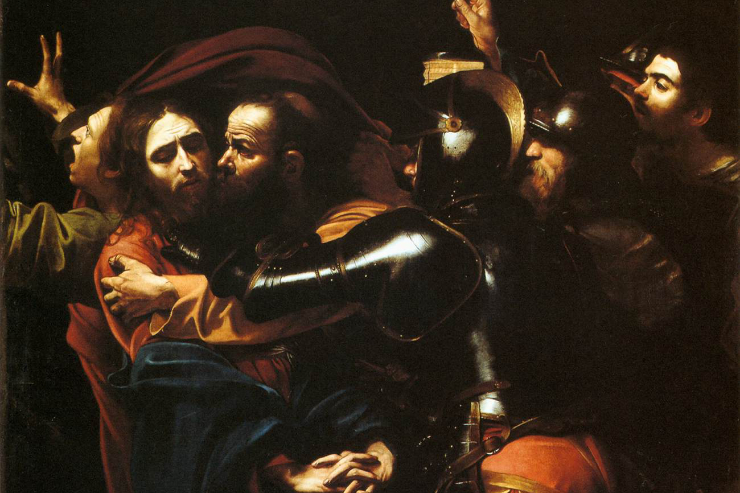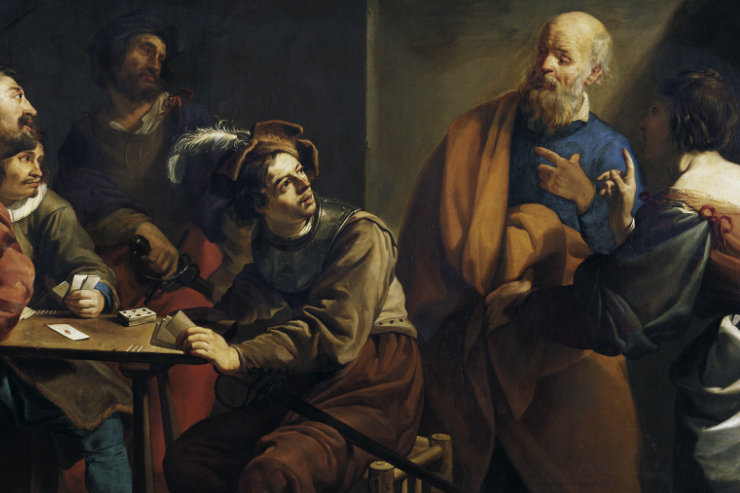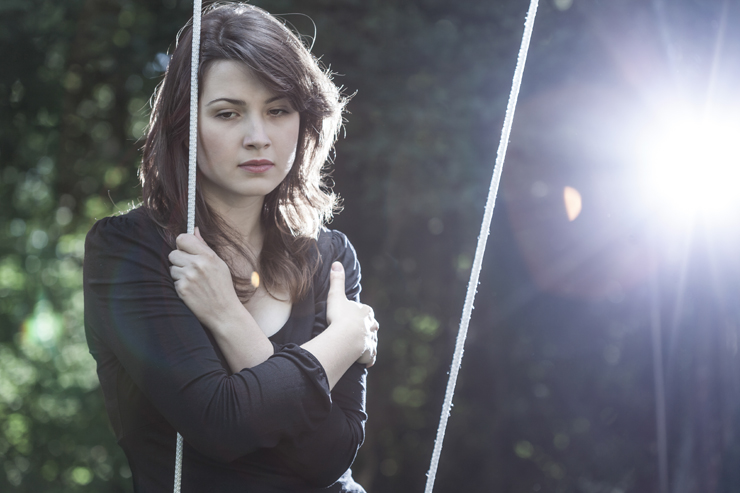I have been fascinated by stories of the Shroud of Turin for nearly 25 years. Never did I imagine that one day I would be bringing my newly confirmed 14-year old daughter Teresa and two of her friends with me to see it. But last April, by piecing together cheap airfares and frequent flier miles the four of us went on a 9-day pilgrimage of a lifetime to Italy that was spiritually transformational.
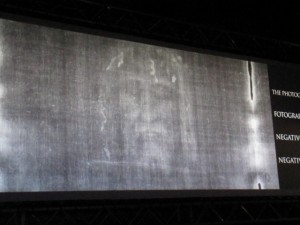 The Shroud of Turin is a 14-foot long by 3.3-foot wide linen cloth that bears the faint image of a crucified man. Millions believe that man to be Jesus Christ. It is said to be the most scientifically studied Church relic ever. And still the origin of this image is debated among scientists, historians and theologians. While no one would ever be required to “believe” that the Shroud of Turin is the actual burial cloth of Jesus Christ, one thing is clear; to this day none of the skeptics can accurately tell us how this bloodstained, linen cloth bears the image of a photographic negative of a crucified man.
The Shroud of Turin is a 14-foot long by 3.3-foot wide linen cloth that bears the faint image of a crucified man. Millions believe that man to be Jesus Christ. It is said to be the most scientifically studied Church relic ever. And still the origin of this image is debated among scientists, historians and theologians. While no one would ever be required to “believe” that the Shroud of Turin is the actual burial cloth of Jesus Christ, one thing is clear; to this day none of the skeptics can accurately tell us how this bloodstained, linen cloth bears the image of a photographic negative of a crucified man.
Earlier this spring from April 10 through May 23rd early two million of the faithful and curious entered the Cathedral of St. John the Baptist in Turin, Italy for a chance to stand for three minutes before the Shroud. On May 2nd, when Pope Benedict XVI prayed before the Shroud two weeks after our pilgrimage to Turin, the Holy Father all but gave an outright endorsement of the authenticity of the Shroud, calling the cloth an icon, “written with the blood of a crucified man in full correspondence with what the Gospels tell us of Jesus.”
For me, seeing the Shroud, and experiencing the other spiritual blessings from Turin, Pisa, Assisi, the Vatican and Rome with my three energetic companions was such a gift. One of Teresa’s two friends along for the pilgrimage was 12-year old Rebecca Liffrig, from a Catholic family of nine children. We’ve known Rebecca’s parents, Mike and Julie Liffrig and their family for 20 years, they live on a farm north of Mandan and we are the Godparents to one of their children. Also traveling with us was 13-year old Samantha Pearson, who has a younger brother. Samantha’s family is Baptist and jumped at the opportunity for her to experience this, as they called it, “trip of a lifetime.” Before I talked about our time in Turin let me write about the lifetime of what many believe to be the burial cloth of Jesus Christ.
The Lifetime of the Shroud of Turin
The preponderance of scientific evidence continues to weigh overwhelmingly in favor of the belief that the Shroud is the actual burial cloth of Christ. Ever since 1898 when Italian photographer Secondo Pia discovered that the image was actually reversed, as in a photographic negative, scientists have attempted to unravel its mysteries. The more we peel back its layers, the more mysterious the Shroud becomes and lives up to one of its earliest descriptions when it was known as “an image not made by human hands.”
This description of “an image not made by human hands” first comes to us about an ancient cloth said to bear an image of Jesus Christ. It was known as the Image of Edessa, the Edessa Cloth and later during the Byzantine Era as the Holy Mandylion. Edessa was a great city during the time of Christ, now known as Urfa in modern day Turkey. There is a high level of certainty amongst scientists, religious scholars and historians that the Shroud of Turin is this ancient cloth.
It is said that this cloth came to Edessa to King Abgar V Ouchama of Edessa (13-50 AD) by the Apostle Thaddeus. This was written about in Eusebius of Caesarea’s early 4th century Ecclesiastical History. He writes about a document once in Edessa’s archives written by King Abgar V and delivered to Jesus by an envoy. The King asked Jesus to come to Edessa and to cure him of leprosy. The history reports that the Apostle Thaddeus was sent sometime after Jesus’ death and that he founded a church in Edessa. A separate Syrian manuscript, the Doctrine of Addai confirms these details and adds that a portrait of Jesus accompanied Thaddeus. It referred to the Edessa Cloth as a tetradiplon. A tetradiplon means a cloth doubled in fours, so that only the face in the cloth would be visible. King Abgar is cured of his leprosy and there are many conversions to the new Christian faith because of the King’s healing and because of the Image of Edessa.
But over the next 5 centuries the people begin to lose their faith and those who are in possession of this Image hide it inside the walls above one of the city gates in Edessa for fear that it would be destroyed. There is also evidence of early first century Roman persecutions that persisted until the time of the Emperor Constantine. In any event, the cloth was eventually lost, or forgotten about until the year 544 AD when it was rediscovered during a Persian invasion and placed in a new Church built especially for it. In the late 6th century Evagrius Scholasticus’ Ecclesiastical History mentions that Edessa was protected by a “divinely wrought portrait.” sent by Jesus to King Abgar. In 730 AD St. John of Damascus in his book On Holy Images talks about the cloth as a “himation”, which is translated as “an oblong cloth or grave cloth.” This is the first time we can be certain that this is not simply the face of Jesus, but in fact an entire image of the crucified body of Christ.
In 944 AD there was an attack on Edessa again, this time from the Muslim invaders. The Cloth of Edessa was transferred to Constantinople, the Byzantine capitol city now known as Istanbul in Turkey. When the image arrived the Archdeacon of the Hagia Sophia Cathedral preached a sermon about the cloth being a burial cloth. It was believed to be Jesus and that it contained bloodstains. There are several historical documents that referred to the Image over the next 250 years.
In 1204 the Shroud disappears from Constantinople when it is sacked by Knights of the Fourth Crusades. The Knights seized numerous relics because of the invading Muslims and once again removed the Shroud. In 1207, Nicholas d’Orrante, Abbott of Casole and the Papal Legate in Athens wrote about the relics taken from Constantinople by the Knights and referred specifically to the Shroud saying that he saw it “with his own eyes” in Athens.
A French knight, Geoffrey de Charny, is the first identified owner of the Shroud after this time and he wrote to Pope Clement VI that he wanted to build a church at Lirey, France for the Shroud. The year was 1354. Large crowds came to visit the church at Lirey to view the Shroud and special medallions were struck. The Shroud remained in the De Charny family for about 100 years until it passed to the Savoy family.
By 1532 the Shroud had been moved to several different locations for security and veneration reasons. And that year the Shroud suffered fire damage in the St. Chapelle Chapel in Chambery, France. It had been located there since 1453. Burns to the cloth resulted from molten silver from the reliquary box in which it was stored in and produced symmetrical marks in the corners of the folded cloth. Poor Clare nuns attempted to repair this damage with patches. There were also a number of water stains caused by the extinguishing of the fire.
In 1578 the future Saint and then Cardinal Charles Borromeo wanted to take the dangerous journey on foot from Milan, Italy to Chambery, France to give thanks in front of the Shroud in thanksgiving for Milan being spared from the ravages of the plague. To save Borremeo such a journey across the Alps, the owners of the Shroud ordered that it be transferred to Turin. It has remained in Turin ever since.
The Science of the Shroud
It would take several books or websites to get into all the scientific testing that has been done on the Shroud of Turin. (And there are several dozen books and websites devoted to the science of the Shroud). Suffice to say that the real testing began in 1978 when several scientists were given access to Shroud for five days. It is known by the acronym, STURP or Shroud of Turin Research Project.
For 120 hours in 1978 the STURP scientists photographed, x-rayed, pressed sticky tape, took samples from the bloodstains, did spectra analysis tests and snapped thousands of photomicrographs of the Shroud. Three years later they released their findings, and 30 years later their study has not been notably contradicted. Among the STURP findings: No pigments, paints, dyes or stains were found on the fibrils of the linen cloth. It is not a painting. An image analyzer shows the Shroud has a unique, three-dimensional codex embedded in it, unlike any other two dimensional image made by humans. While some explanations of what caused the image on the Shroud are possible from a chemical point of view, there are precluded by physics and certain physical explanations are conversely completely precluded by the chemistry. To explain the Shroud image there must be a complete explanation from a physical, chemical, biological and medical standpoint. To date no one has presented this complete solution. It is an enigma.
The best scientific explanation is that the Shroud image was produced by something which resulted in “oxidation, dehydration and conjugation of the polysaccharide structure of the microfibrils” of the linen itself. STURP concluded that for now that the “Shroud image is that of a real human form of a scourged, crucified man. It is not the product of an artist. The blood stains are composed of hemoglobin and also give a positive test for serum albumin.”
The scientists also determined that there is evidence on the Shroud to show that it has pollen on it that can be traced to all the known locations at the specific times in its history: from Jerusalem to Edessa to Constantinople to Athens to locations in France and Italy.
In 1988 Carbon-14 tests seem to indicate that the cloth was dated to between 1190 and 1350 AD. This led some to believe it was a clever medieval forgery. But since that time those results have been called into question on a number of levels and now the Carbon-14 tests themselves have been largely discredited.
Our Pilgrimage to See the Shroud
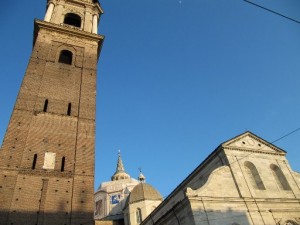 When I originally booked our free Shroud of Turin tickets online in the US before flying to Italy, I had hoped to have at least 3 or 4 viewing times and spend at most 10-12 minutes in total in front of the Shroud. God had other wonderful plans for us. After a 30-hour odyssey of flying from our homes in North Dakota, making train connections through Rome to Milan and Turin, checking into our B and B and then hiking the 20 minutes on the ancient cobblestone streets and plazas of Turin, we finally had our first chance to stand in line with others to see the Shroud of Turin. Coming up to St. John the Baptist’s Cathedral the early evening sun lit up the old dome perfectly and we found out where to line up to prepare for our viewing. I had expected to wait for hours. In just over 20 minutes we were ushered into the sanctuary and beheld the Shroud.
When I originally booked our free Shroud of Turin tickets online in the US before flying to Italy, I had hoped to have at least 3 or 4 viewing times and spend at most 10-12 minutes in total in front of the Shroud. God had other wonderful plans for us. After a 30-hour odyssey of flying from our homes in North Dakota, making train connections through Rome to Milan and Turin, checking into our B and B and then hiking the 20 minutes on the ancient cobblestone streets and plazas of Turin, we finally had our first chance to stand in line with others to see the Shroud of Turin. Coming up to St. John the Baptist’s Cathedral the early evening sun lit up the old dome perfectly and we found out where to line up to prepare for our viewing. I had expected to wait for hours. In just over 20 minutes we were ushered into the sanctuary and beheld the Shroud.
There were signs up not to take flash photos, and I was careful to take non-flash pictures and videos. I wanted to record this moment for all those millions who won’t be here to see and feel what I felt. I had heard the image was so faint it was hard to make it out and you needed time to discern it. I was prepared for that and felt quite the opposite. The Man in the Shroud seemed to be very real and very profound and very Holy. I felt a tear in my eye as I prayed a prayer of both thanksgiving for both being there and for love that Christ outpoured for his creatures during his time on the cross.
I didn’t want it to end. And neither did my three fellow pilgrims. And we knew it wasn’t going to end since we would be back the next day to again deeply contemplate this mystery. It is a dual mystery on many levels. One is the Shroud itself and its ability to draw nearly two million people for the next six weeks. Another is looking at what they see as the Holy Face of God accepting the will of God for the creatures of God to be with Him for an eternity.
The next day we went to Mass at one of the 68 Catholic churches that are nearly everywhere you walk in old Turin. By chance it was the church of St. Charles Borremeo, dedicated to him in 1609, the former Archbishop and Cardinal from nearby Milan who, by wanting to hike to France to see the Shroud, is credited with having it being brought to Turin in 1578.
Following Mass we made our way to the Shroud Museum. Inside were remarkable photos, paintings and depictions of where the Shroud is believed to have been through the last 20 centuries. For those who wonder if the Shroud is a medieval forgery, there are plenty of scientific and contemporary records through the centuries to show that the Shroud has indeed existed since the time of the burial of Christ.
This museum also contained replicas of what the nails, the Roman whips that scourged Jesus and His crown of thorns (really a cap of thorns) would have looked like. In addition there was the actual silver case that the Shroud was held in when not on display in the Cathedral. This was the silver box that firefighters are seen carry from the Church when fire broke out mysteriously in 1998, nearly again destroying the Shroud. Three times, first in 1532, fire has broken out in Churches that housed the Shroud, and three times it was saved.
After a brief lunch we walked the few blocks to get in line to see the Shroud again. Unlike the evening before, there were many more people in line at midday. We walked ahead of hundreds trying to find someone who spoke English to converse with, wanting to ask some questions for this article about where they were from and their reason for wanting to see the Shroud. But everyone was Italian, a lot of them groups of school children, and their English skills were like my Italian skills — not very good!
And just like the evening before, we were ushered into the darkened Cathedral of St. John the Baptist to be given a chance to stand six feet from the “image not made by human hands.” Again we spoke afterwards about how intense those three minutes feel. You want to pray and do, you want to focus on the image and do, you want to listen to a prayer that is said in Italian and try to understand and cannot. And then those three minutes are over and you are quietly asked to leave the sanctuary. You are glad you came but the time is so short.
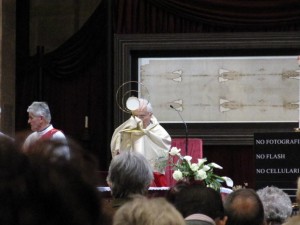 Outside the Cathedral there was Eucharistic Adoration and confessions being heard. We were happy to learn that for the three of us that are Catholic, we can receive the Sacrament of Reconciliation because there were priests who speak English. Father Alberto heard my confession after my daughter Teresa saw him. We talked for a bit afterwards and he told me he was from Turin and felt blessed to be offering this Sacrament to the pilgrims that come from around the world here. “I like helping people that are on the Way. It is a tremendous blessing,” said Father Alberto.
Outside the Cathedral there was Eucharistic Adoration and confessions being heard. We were happy to learn that for the three of us that are Catholic, we can receive the Sacrament of Reconciliation because there were priests who speak English. Father Alberto heard my confession after my daughter Teresa saw him. We talked for a bit afterwards and he told me he was from Turin and felt blessed to be offering this Sacrament to the pilgrims that come from around the world here. “I like helping people that are on the Way. It is a tremendous blessing,” said Father Alberto.
We spent time then — even Samantha, our Baptist pilgrim — before the exposed Blessed Sacrament in silence. We then decided to visit the Turin Diocesan Museum located underneath the Cathedral. It was a choice that the teenage girls fought me on a bit, because we had already seen the Shroud Museum and they “strongly” felt that they wanted to wander around more and perhaps do some shopping for presents to take home to family and friends. I insisted on seeing this museum. And like all things, God was guiding us this trip and He has a happy surprise for us following our museum tour.
The Turin Diocesan Museum contains samples of the architecture, art, and archeology of the Cathedral that dates back through the last 18 centuries. We learned that the Cathedral was founded during the very earliest Christian times and built next to the existing Roman walls at the side of a theater, the ruins of which are still visible under the massive Cathedral. Beautiful large paintings from the 15ththrough 17th century that once adorned an earlier Cathedral now hang on the walls in the basement. Also you can see ornate ancient vestments, chalices, statues, crosses, giant candle holders and gem-laden gold and silver monstrances and even elaborate ancient tabernacles. Again we were awestruck at the beauty and craftsmanship of everything we saw.
At the end of the tour we came out of the Cathedral basement and are led back to the front steps. Behind us was the very line of people waiting to get into see the Shroud. The doors to Cathedral were open and people were walking inside to the main body of the Church, so we looked at each other and followed them inside.
I had wondered about the people behind us in the pews in the main body of the Church who were kneeling and praying when we came down the side aisle and had our three minutes in front of the Shroud earlier in the day and the evening before. I thought you needed special permission, or had a special pass. Turned out you don’t need anything at all. While you were not six or ten feet away from the Shroud, you still had a wonderful view and could be as close as 25 feet.
And so my daughter Teresa and her friends Rebecca and Samantha found out that by going to the Diocesan Museum, somewhat against their will, they were able to sit, kneel and even stand for well over a half hour and venerated this mysterious Shroud. We watched the comings and goings of thousands of pilgrims, like we had been, and listened to that beautiful Italian prayer over and over again said so reverently each time. We prayed rosaries, said Chaplets of Mercy and just sat in silence, knowing what a special 30 minutes we all were having together.
As we left we found out that Mass was said there at 7 a.m., and so we planned to be back the next day.
There are certain Masses we all remember. Some of us remember our First Communion, Confirmation, Marriage and other special ones. I will always remember the day when I took part in a Mass, concelebrated with 10 Italian priests in front of the Shroud of Turin at St. John the Baptist’s Cathedral. As we discovered the day before, there was no need for a ticket to enter the main sanctuary of the Cathedral to venerate the Shroud, nor was there any reservation required for the daily Mass at 7 a.m.
Attending this Mass gives one a sense of wonderment when you stop and think about where this linen cloth has purported to be these last 20 centuries. How many people have stood before this bloodstained, ancient cloth and received the body and blood of Christ during Mass and then reflected upon what Christ did for us by dying on the Cross. His last moments before passing into His eternal reward are mysteriously etched onto the Shroud. The Apostles were the first to see this linen cloth, King Abgar then was cured of his leprosy and its journey from there has meant it has been at Mass before literally millions of the faithful through 20 centuries. I couldn’t help but think when Peter entered the empty tomb and saw this linen cloth lying inside “and believed”, could it have been this imprint I was looking at on the Shroud that helped him and the others overcome their initial unbelief?
Here I was at a Church built on a site of earlier Catholic churches that date back to the 3rd century. Mass has been said here for well over 1800 years. At the precise moments when the priest lifted up the bread and wine to confect them into the Body and Blood of Christ, my eyes lined up with the Shroud. There were the bloodstains, there was the crucified body, there was our Creator who suffered, died and was buried for all of us. Emotionally and spiritually I knew that communion would never, ever be the same for me again.
We are the body of Christ. There was the body of Christ. Transubstantiated by the Italian priests and physically represented in one of the Church’s most venerated relics. The choir began to sing angelically as we all went up to receive, with my eyes focused again on the Shroud. And then, another profound moment; the Eucharistic Procession to the chapel room across the courtyard where Eucharistic Adoration took place during the Shroud exhibition.
Then the Mass at St. John the Baptist’s was over. I walked forward to the front pews to kneel and say a Rosary and a Chaplet of Mercy. Finally it was sadly time to leave. While the rest of the trip to Pisa, Lorenzana, Assisi, the Vatican and the rest of Rome was spectacular, nothing will compare with the first two days in Turin. It is a story that I will relive forever.
The Shroud remains at the Cathedral in Turin, but its next public viewing is not scheduled until the year 2035 (unless there is a special opportunity permitted as there was this time). As noted before, it will never be a requirement for those in the Catholic faith to accept that the Shroud is the true burial cloth of Jesus Christ. After seeing it four times and spending nearly three hours in front of it, we know there was a linen cloth 2,000 years ago that was used to bury our Lord before he was laid in the tomb. Science has not been able to replicate this bloodstained shroud precisely or prove that it is not what it is purported to be.
Upon landing at the airport in Minneapolis/St. Paul and ready to board the final leg to our homes in Bismarck, we met up with our dear friend the Vocations Director for the Diocese of Bismarck, Father Tom Richter. We were excited to tell him about our time in Rome with his seminarian students and our trip to the Shroud of Turin. He turned to the girls and said, “I hope you three realize the tremendous gift you have been given. You probably won’t realize the significance of what you have experienced until you are much older.”
If anyone is interested I have put together a PowerPoint presentation about the Shroud of Turin, including slides and pictures that I gathered while in Turin this trip. I would be happy to provide it to you or present it to your Church gatherings anytime. You can contact me through our website, www.RaisingCatholicKids.com Highlights from the entire trip are posted here, http://gallery.me.com/markarmstrong2#100392
For excellent websites about the Shroud of Turin see:
- www.Sindone.org (the official website in Turin)
- www.Shroud.com
- www.ShroudofTurin.com
- www.ShroudStory.com
If you liked this article, click on “Recommend” to share with your Facebook network. And please share your thoughts on this article by submitting your comments below. – The Editors



